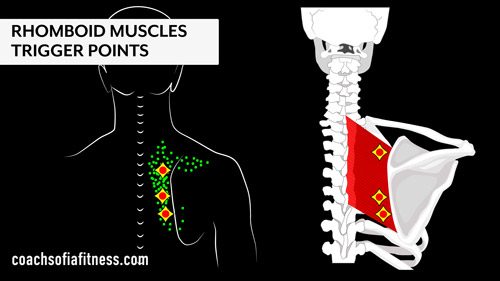
If you experience pain in the Rhomboid muscles, this post should help you alleviate the symptoms and get relief.
Rhomboid pain is usually felt between the shoulder blade area and the spine. And it’s to as interscapular pain.
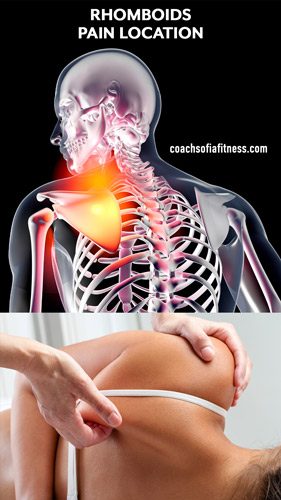
Any pain in the cervical and thoracic spine can make moving the head and arms difficult. Rhomboid pain, in particular, can make breathing difficult.
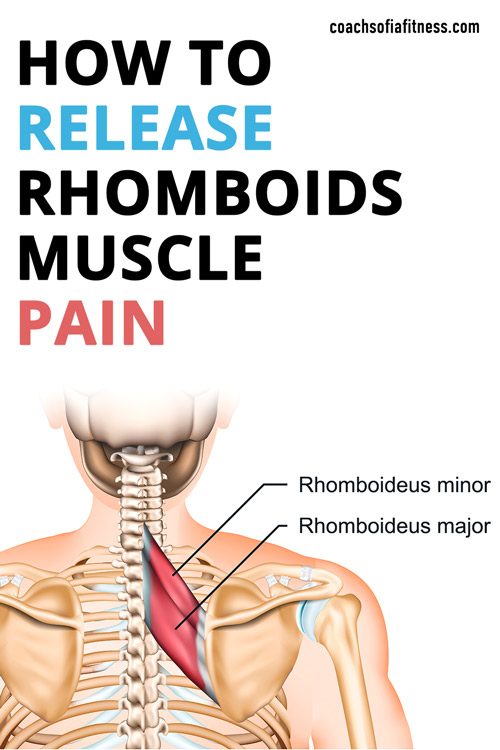
Here’s what you’ll learn in this post:
- A brief description of the rhomboid muscle group so you can quickly know how to release them.
- Trigger points and pain referral patterns.
- Cervical spine issues that can trigger pain in the rhomboids
- Strengthening and corrective exercises to fix the weakness.
- How to properly release and stretch the rhomboids.
- Sleeping tips to alleviate symptoms at night.
Anatomy of The Rhomboid Muscles:
The rhomboids are a muscle group consisting of the Rhomboid Major and Rhomboid Minor. The rhomboids are crucial in stabilizing the shoulder girdle and scapula (1).
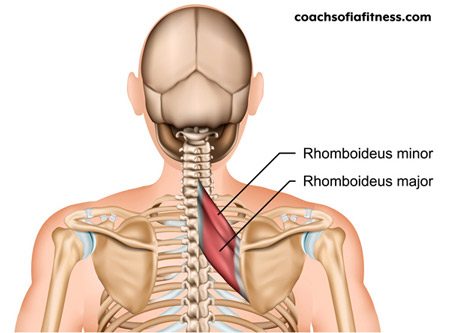
The rhomboids are deep into the trapezius. In fact, the rhomboids, along with the trapezius, pectorals, latissimus dorsi, sternocleidomastoid, and serratus anterior, form the shoulder girdle.
Location and Functions:
Here’s a brief overview of the location and functions of the rhomboid muscles. You can target the muscle better when you know its location and function.

- Origin: Spinous processes of C7- T5
- Insertion: Medial border of the scapula
- Isolated function:
- Concentric action produces scapular retraction and forward rotation
- Integrated function:
- Eccentric action – scapular protraction and upward rotation
- Isometric action: Stabilizes the scapula.
Rhomboid Pain Referral Pattern
Rhomboid Muscles Trigger Points:
Trigger points referral pain is mainly local to the muscle area. The pain is felt around the shoulder blade area and the external aspect of the spine (2).
Most people report pain in the shoulder blade area when dealing with rhomboid pain.
If you are experiencing pain when turning your head to one side, I’d advise you to perform deep tissue release on the upper trapezius, mid-trapezius, and rhomboid area. Here are the areas to focus the massage ball on.

Notice if this reduces the pain when rotating your head. If it does, you can continue with that daily until the pain subsides. Along with the exercises I’ll share below, this should help reduce the pain over the next few days.
Remember to keep doing these exercises at least 2-3 times a week for maintenance.
Before we get to the exercises, I want to briefly talk about an interesting study that looked at a different cause of rhomboid pain.
Diskogenic Syndrome:
I spent a few days looking at research articles to learn more about all the possible causes of rhomboid pain. I discovered a study suggesting that rhomboid pain may be caused by problems in the cervical spine that affect nerves and transmit pain to surrounding muscles.
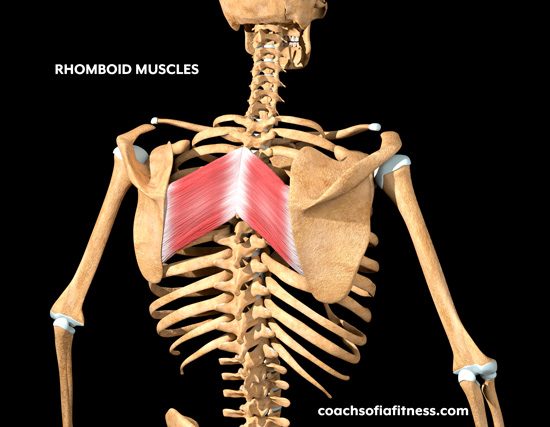
This is called diskogenic syndrome and was discovered in 1959 by Dr. Ralph Clowards.
In diskogenic syndrome, pain originates in the intervertebral disc and surrounding ligaments. This study showed that sensory nerve endings are responsible for symptoms of pain in the neck, scapula, shoulders, and upper arm after injections to stimulate that area directly, which caused muscle spasms in the shoulder girdle in that area. These spasms were due to local reflexes (3, 4).
This study showed that this pain originated in the periphery of the cervical disc and surrounding ligaments. Also, the sensitivities felt were due to abnormal movement of the vertebral joint associated with the affected cervical disc region.
Therefore, if the pain persists and becomes more chronic, especially if you have pre-existing spinal issues before developing rhomboid discomfort, an examination of the cervical spine is recommended.
I love strengthening exercises because they help stabilize the spine and add ‘tightness’ to that area. I’ve noticed that keeping my spine stable has paid off in many ways.
I’ve created 7 routines to help you stabilize your cervical and thoracic spine inside Trapezius Control program.
The exercises below should help you reduce rhomboid pain and stabilize that area.
Before the exercises, I recommend you spend a few minutes rolling the rhomboid area to release any tightness and also to warm up the muscles.

Full disclosure: this post contains Amazon affiliate links. I only mention products I personally use and recommend…and if you purchase from Amazon using my affiliate link, I get a small commission. You won’t pay more.
Related Posts:
Rhomboid Pain Exercises & Stretches
Band Pull-apart
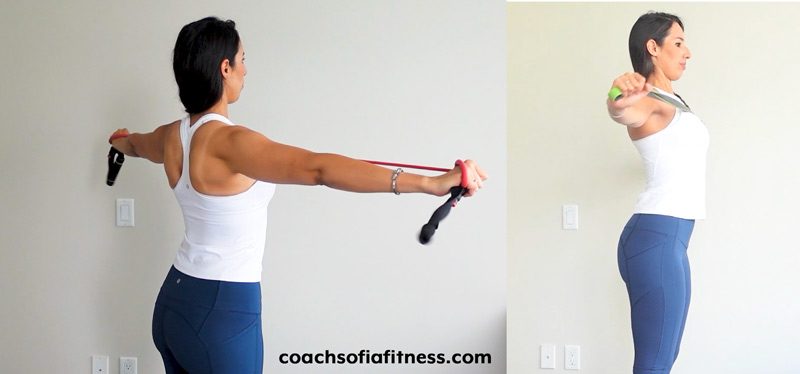
This exercise will target the rhomboid muscles and strengthen the area. Grab an open-ended or closed-ended band.
- Keep your shoulders down and relaxed.
- Hold the band at the end.
- Extend your arms in front of you.
- Pull the band towards your chest and tighten up your shoulder blades at the end. Bring the band as close to your chest as you can.
- Squeeze your back muscles and slowly release
YTW Scapular retraction
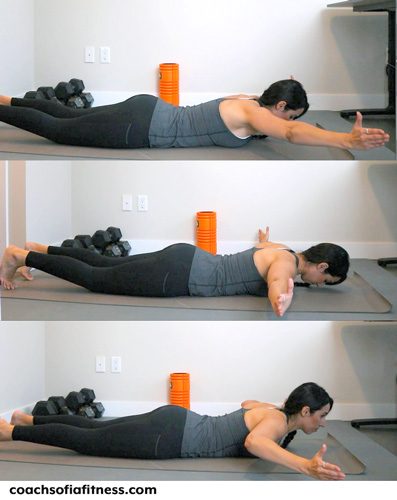
- Reach out with your arms to form a Y shape while resting your arms on the mat.
- Raise your arms using your back muscles (avoid shrugging).
- Rest your arms down. Then, raise up using your back muscles.
- Keep the external rotation by keeping your thumbs up and focusing on the extraction at the top.
- Extend and bend your arms with your thumbs to point out
- With your arm resting, raise your arms up and externally rotate your shoulders to form a W shape.
- Alternate for 12-15 reps.
Face Pull
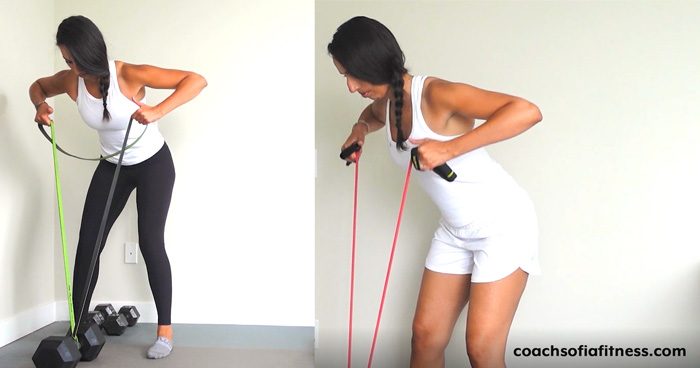
The face pull exercise is one of the best exercises to target the rhomboid muscles. Focus on squeezing your shoulder blades together and pausing for a second.
You can use a cable machine as well for this exercise, but I’d like to give you this band option you can do at home.
- Anchor the band to a heavy item. I’m using my heavy Dumbbell.
- Hold the band in the middle.
- Hinge at the hips and keep your core and glutes tight.
- If you’re using a cable machine, you’ll be standing. Keep your core tight for stability.
- Pull the band towards your face. Your hands should go toward the sides of your face, not the front.
- Focus on the rhomboid muscles and squeeze your shoulder blades together.
- Slowly release and pull again.
Recommended program: Trapezius Control
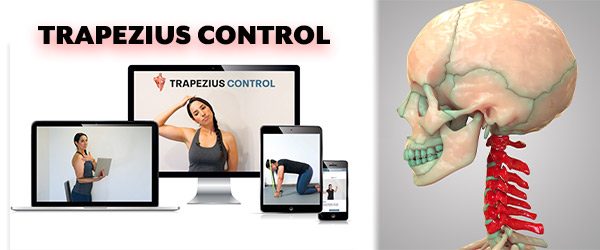
Band External Rotations
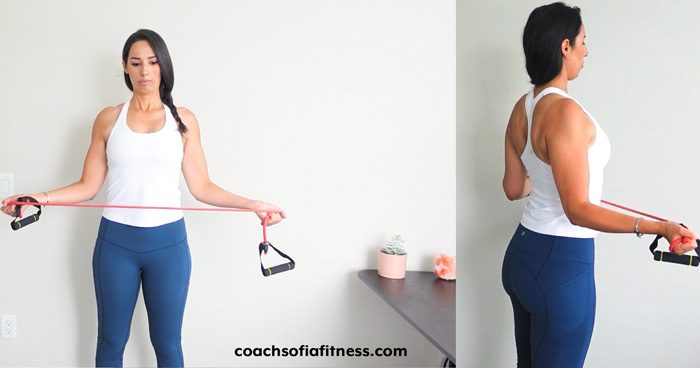
- Hold the resistance with your arms facing right in front of you.
- Bend your elbow at a 90-degree angle.
- Rotate your arms externally.
- Pull the band outwards as you externally rotate your arms out and squeeze your shoulder blades.
- This is a small yet important exercise.
- Control each repetition and focus on the posterior shoulder muscles to do the work.
Band Back Rows
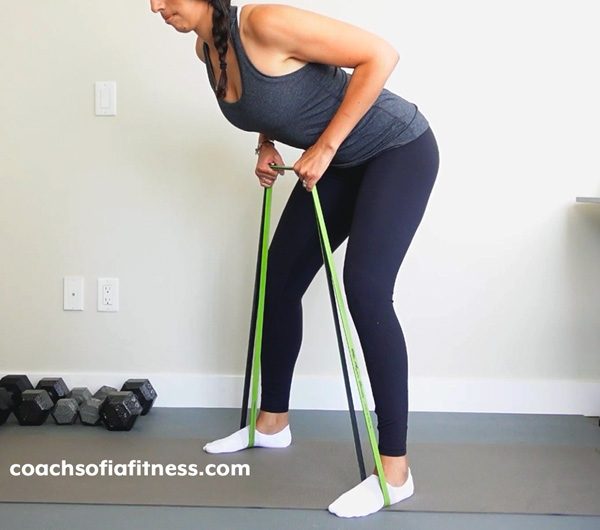
- This is a great low-impact exercise to perform back rows without dumbbells.
- Anchor the band under your feet. Grab the middle of the band.
- Engage your core. Hinge at the hips and keep your back stable.
- Pull the band towards your chest and squeeze your back muscles.
- Slowly release the band and repeat.
One Arm Dumbbell Row
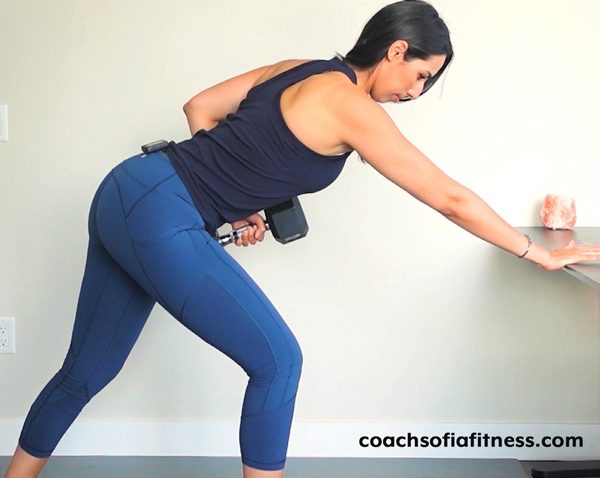
The one-arm DB row is a great traditional exercise to strengthen the back. Doing the exercise one side at a time allows you to reduce the load on the back while focusing on the back contractions.
When you perform the row, squeeze at the top and slightly open up your chest as you rotate outward. This contracts the rhomboids just a little more. Keep your back stable and use your back muscles mostly to avoid compensation.
Pullovers

The pullovers target the lats mainly. And this helps to stabilize the thoracic spine and activate the mid-back muscles.
I prefer to do this exercise on the floor for additional stability. When tired, you can just drop the Dumbbell behind you on the floor.
- Maintain a neutral spine. Tighten up your core. Hold the Dumbbell with both hands.
- Keep your arms straight with a slight bend. You don’t want to turn this exercise into a triceps extension. You want to move your whole arms back and forward.
- Lower your arms back. Feel your lats stretching and raise your arms back forward.
- Focus on each contraction and feel the muscles working.
Resistance Cervical Tension

The best way to do this exercise is using a stability ball. However, you can also use a memory foam pillow. I also do this exercise when driving using my car headrest. This is an excellent exercise to strengthen the deep cervical muscles.
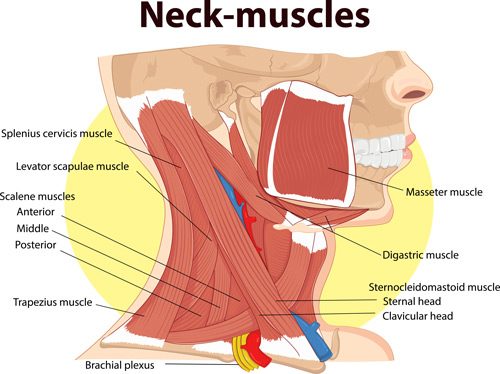
- Place the ball behind your head.
- Relax your shoulders and focus on activating your neck muscles to press against the ball.
- Slowly release to the starting position.
Bent Over Rear Delt Raises
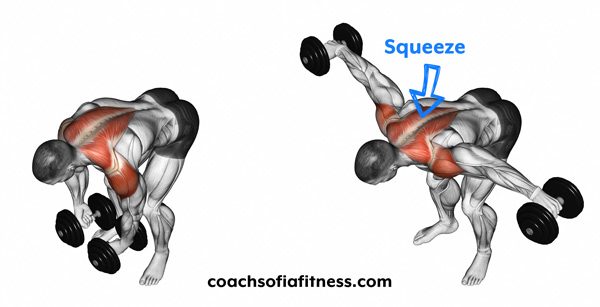
I recommend you lead your buttocks against the wall for support. You can also do this exercise one arm at a time while supporting the other side against the wall to reduce the load on your spine.
- This exercise is excellent for isolating the rear deltoids and rhomboid muscles.
- Keep your core engaged for stability.
- Raise the dumbbells and focus on squeezing your mid-back area.
- Also, try not to shrug your shoulders. Focus on the upper back and mid-back area to raise the weights.
If you are at the gym, try the upright row exercise with the cable machine and make sure you squeeze at the top.
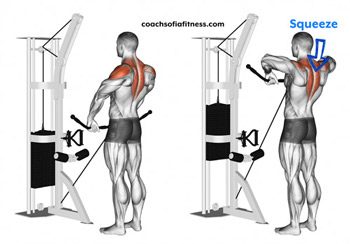
Stretches for Rhomboids Pain
Thoracic Rotations

- Keep your hips stable
- Bring your elbow inward to stretch out the mid back
- Rotate out and bring your elbow up toward the ceiling
- Repeat 7 times on each side
Read Deltoid and Rhomboid Stretch
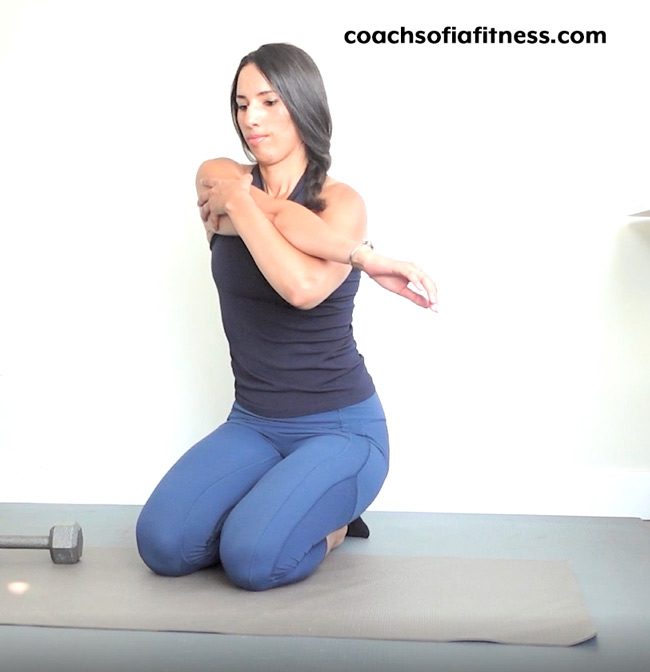
- Get into the lunge position next to a wall.
- Extend your arms.
- Keep one arm forward and rotate your arm in a circular motion over your head while keeping your arm closer to the wall.
- Follow your arm movement with your eyes/
- Video tutorial of this thoracic stretch here.
Wall Windmill
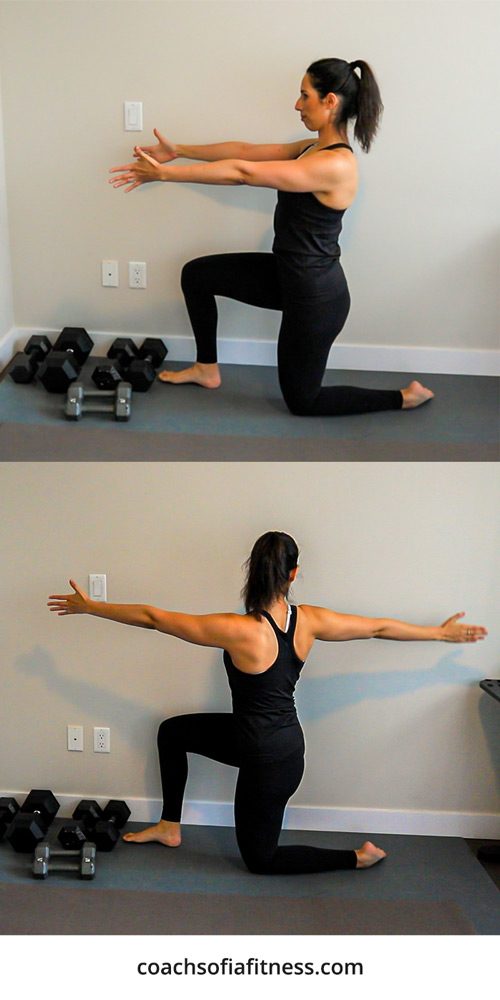
This mobility stretch is amazing for the upper and mid-back area. It’s very beneficial for the thoracic spine.
Recommended program: Trapezius Control
Sleep and Rhomboid Pain
Any posture we hold for a prolonged period affects the muscles. Good quality sleep helps restore the nervous and muscular systems. Sleep can also contribute to more pain.
Many people report their neck and upper back pain worsening when waking up due to not holding a good posture. We put out bodies in more stressful positions for hours at night.
Below are a few tips that can help you sleep with a better posture and avoid tightness developing in the shoulder blade area, including rhomboid pain. I have a detailed post here on the best sleeping position for back and neck pain.
- Check your neck position when sleeping on your back and side. My neck and shoulder pain dramatically decreased when I switched to a soft low pillow. Higher pillows that put my neck into flexion were causing me neck strain and frequent upper trapezius tightness. Notice if you use a low or high pillow and switch to one that puts your spine in a neutral position when sleeping on your back.
- It’s helpful to hug a pillow when sleeping on your side if you are experiencing pain. Hugging a pillow stabilizes the shoulder joint and puts your shoulders into a better position. Without this, we can quickly round the shoulder, stretching the mid-back muscles and causing weakness in the rhomboids. The pillow will help you keep a neutral spine.
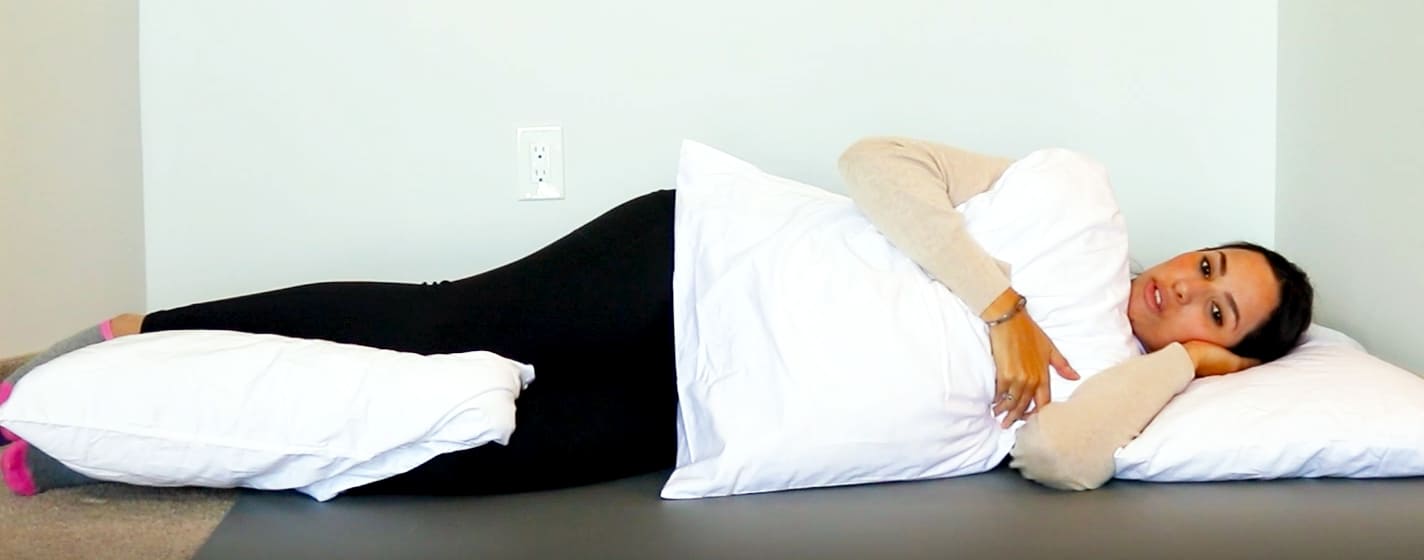
- An acupressure mat can also help you release muscular tightness and help you sleep. I love my acupressure mat and regularly use it after a warm shower before bed.
I hope this post has been helpful. My goal was to be as thorough as I can to help you fix Rhomboids pain. If you have any questions about anything, comment below.
If you found the post beneficial, consider sharing it with others.
Leave a Reply